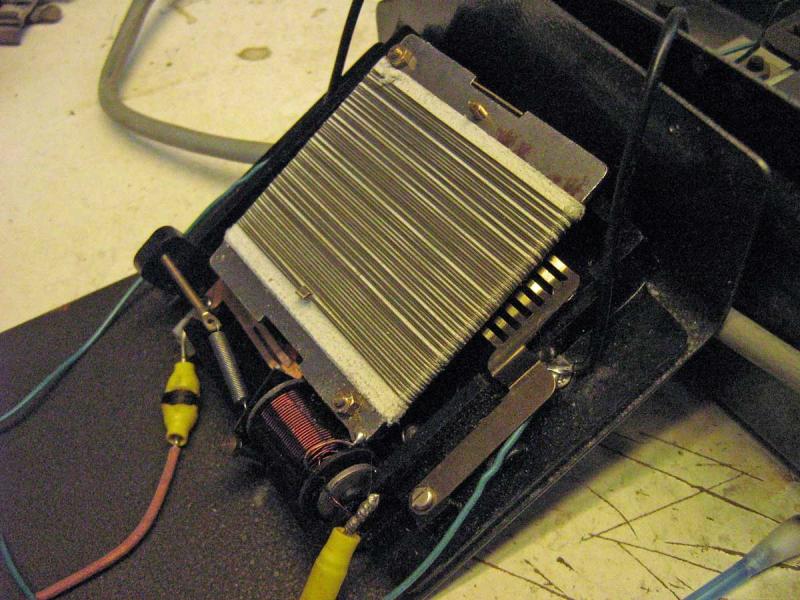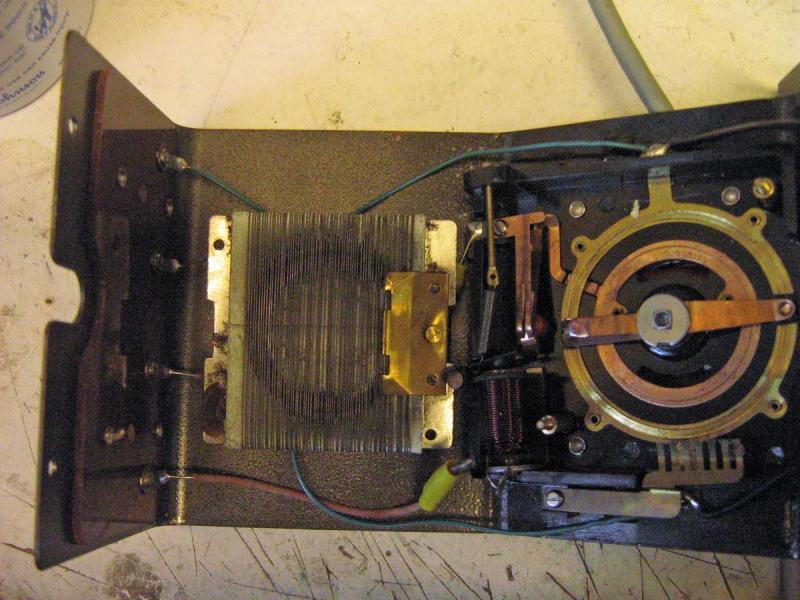Old Triang 4-5 Controller
Posted
#215425
(In Topic #11763)
Full Member
As it has screws holding the case together i thought I might as well look inside. What I found was the most peculiar layout i have ever seen. The rheostat is very strange. I took some pictures which are below,

This is the back of the rheostat on the control panel. Coil at the bottom is the overload cut out and comb piece on the side is the low/high resistance mechanism. As I could see that the square coil would come away I took it off.

On the left the front of the coil. It is turned through 180 degrees. The brass plate is downwards on the right side of the contact rings. One output is connected to the corner of the coil, the other to the centre of the ring and it reverses the supply when at the centre position shown. How the contacts rub the coil can be seen.
I assume there must have been cost benefits in this layout which looks very crude. It obviously works. I have yet to try it out with a loco on a layout as this was carried out in the garage. Crude it might be but i reckon it could last forever. Overload cut out works and resets. Not sure what effect the high/low resistance is meant to have though. Hardly affected the output.
I followed this by dismantling a basic 0-4-0 Triang Rovex chassis. Cleaned it up and got it going. Three more to go including a Hornby Dublo Bo-Bo diesel which I thought was missing the centre contacts. Reckon on inspection it is a two rail version, but they have obviously used the stock of three rail chassis.
freelance model railways and tramways
index02
index02
Posted
Site staff

The high/low can really only be detected when a loco is in use - a voltmeter on the output is not much of a load to give the effect needed.
Ron
NCE DCC ; 00 scale UK outline.
NCE DCC ; 00 scale UK outline.
Posted
Full Member
You wrote =
No sparks, smoke or electric shock and according to my voltmeter an no load output between 9 and 19 volts, which seems a bit high but electrical theory is not my strong point.
The no load voltage is exactly that and if you were running the train and measuring the voltage, you would see it as being around the 12 volts. There are several reasons why this happens and I am not going to blind you with science but that is OK. Chances are your great grand children would conceivably be able to use it… they are pretty bombproof!
Cheers
Trevor
 Last edit: by xdford
Last edit: by xdford
Posted
Inactive Member
Posted
Site staff

Ed
Posted
Full Member
As for the controller the lead while red and black wires looks like it is of the post rubber era. Obviously I had to fit a plug and to be honest the wire was as good as new.
freelance model railways and tramways
index02
index02
Posted
Full Member
Bill
At 6'4'', Bill is a tall chap, then again, when horizontal he is rather long and people often used to trip over him! . . . and so a nickname was born :)
Posted
Inactive Member
Posted
Inactive Member
At its basic level is a:
Visual check for
damaged flexes, plugs, and equipment,
Correctly wired plugs and correctly rated fuses.
Then
an earth continuity test
An insulation test.
A polarity test
And an earth leakage test.
Not all the tests have to be done as on some equipment you can't do it, or it may damage equipment.
Class 1 equipment is metal cased or has an earth point then you can carry out most tests
Class 2 equipment is double insulated so there is nowhere to connect up to do the earth tests.
There is no legal requirement for it to be done!!
But in certain circumstances you need to be able to prove your equipment is safe.
Eg If you are a landlord,
And the one that gets most of us at an exhibition, if the insurance company and therefore the show organisers says so.
This is a very abbreviated explanation, there are ifs, buts and qualifications to all the above but I ain't typing it all!!
 Last edit: by The Q
Last edit: by The Q
Now I've finally started a model railway…I've inherited another…
Posted
Site staff

Example
http://www.patinfo.co.uk/pat-testing/selling-used-electrical-appliances.html
Think it was mainly to ensure that if something was sold and the buyer was injured, the seller wouldn't be liable.
Don't know what the outcome was, or whether this controller would pass with a screwed rather than riveted case.
That said, you can still buy uncased transformers :???:
Ed
Posted
Inactive Member
I work at a site that produces thousands of pieces of electronic equipment, ranging from under a hundred pounds to Several Hundreds of thousands of pounds, they are all held together by screws (and bolts)
You only go inside plugs and extension Sockets.
And a pet P.A.T hate of mine…..
Some P.A.T personnel have claimed that wooden boxed transformers are incorrect as;
A, they may get damp
B, They may catch fire.
To which my answer B******X,
Firedoors are made of wood because it's actually quite hard to get wood to catch fire. (harder than a cheap Chinese plastic Brick PSU)
Every Marshall Mixing desk / powered Speakers / Amplifier is in a wooden box and they have FULL C.E approval.
 Last edit: by The Q
Last edit: by The Q
Now I've finally started a model railway…I've inherited another…
Posted
Site staff

Used to have to have PAT testing done yearly on all the PCs and associated extension leads etc. when I was at work.
Was some years ago, but a right pain with disruption to over 500 users and took a week, even getting some done out of office hours.
Also remember the old transformer/controllers used to have a label with something like 'No user serviceable parts inside' on the riveted case.
Was that just to stop anyone being inquisitive and voiding any guarantee ?
Ed
Posted
Inactive Member
When the P.A.T. arrived companies pushing it and in house Health and safety officers went overboard insisting on everything needing testing every year. The advice from H.S.E is somewhat different.
http://www.hse.gov.uk/electricity/faq-portable-appliance-testing.htm
Desk Computers for instance don't need testing every year, you plug them in and leave them there are not carted around and damaged.
A portable computer PSU should be tested every year as it is carted around and could be damaged, the computer itself doesn't need testing it's not mains powered. The PSU is almost certainly Class 2 (double insulated) and only needs a much shortened test
There is no" Domestic " P.A.T. the one at your site was on a commercial premises, (Selling Education?), A landlord is carrying out a commercial business selling Accommodation, A model railway exhibition is selling the viewing of our railways.
P.A.T. is not required on Home Equipment, unless it is being sold, (giving away for free is counted as being sold).
I Calibrate 9 major equipments at work, requiring a total of 52 major 3 day calibrations ( plus lots of smaller items mostly resistors and shunts) the P.A.T. I do is exactly the same as required anywhere else, and it is done annually due to the value of the items. Not because they need it. plus I also P.A.T our M.R.C.
We did have an outside contractor come in recently as they decided to P.A.T. everything, we don't have the time, and other departments don't have the qualified staff, he succeeded in blowing up some very expensive equipment…. !!!
Now I've finally started a model railway…I've inherited another…
Posted
Full Member
Thanks for the PAT test info. It came in just before I retired and we were subjected to a lot of jobsworth b******t. I think all the extension leads failed first time around, probably being plastic they failed the earth test!!!!!!!!!
freelance model railways and tramways
index02
index02
1 guest and 0 members have just viewed this.

